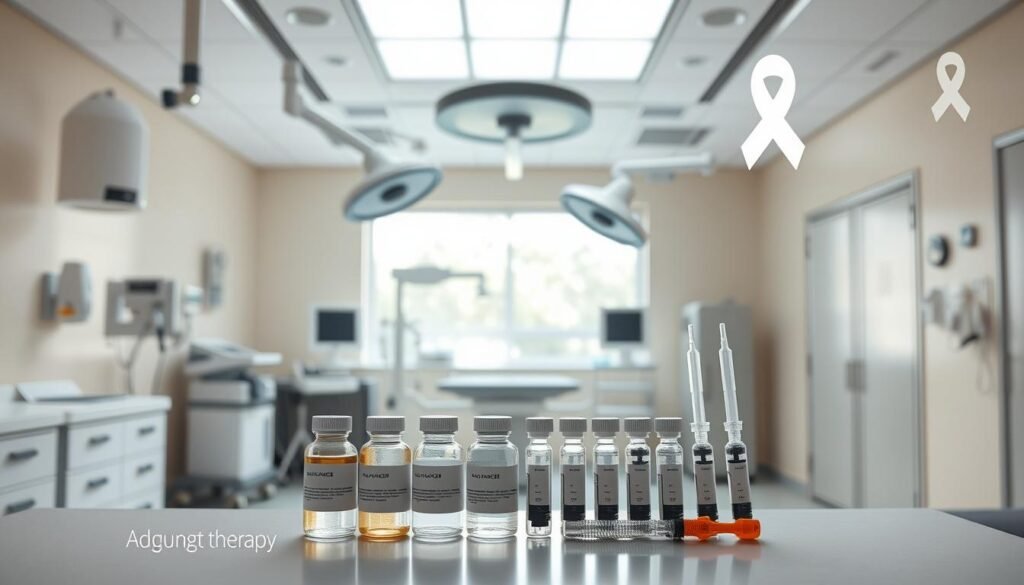In 2024, it’s estimated that 234,580 people in the United States will be diagnosed with lung cancer. This startling fact underlines the importance of knowing about treatment options. Specifically, non-small cell lung cancer (NSCLC) makes up a large part of these cases. For those faced with this diagnosis, understanding non-small cell lung cancer surgeryis vital. This comprehensive treatment guide explores different surgical methods, risk factors, and how they affect survival rates. Our goal is to offer clarity and hope to those on their treatment path. For more information on lung cancer surgery options, visit this resource.
Key Takeaways
- In 2024, about 234,580 new lung cancer cases are expected in the U.S.
- NSCLC surgeries, like lobectomy and pneumonectomy, differ widely.
- Knowing the stage of lung cancer is key for surgery decisions.
- Post-surgery care is crucial for handling complications and recovery.
- The stage of the disease at diagnosis affects survival rates significantly.
- Technological advances, such as VATS, have bettered surgical outcomes.
Understanding Non-Small Cell Lung Cancer (NSCLC)
Non-small cell lung cancer (NSCLC) covers several lung cancer types not labeled as small cell. It includes forms like squamous cell carcinoma, adenocarcinoma, and large cell carcinoma. Smoking is a big risk factor for NSCLC. Adenocarcinoma can also occur in non-smokers.
Lung cancer is the top cause of cancer deaths in the U.S. By 2024, there will be an estimated 234,580 new lung cancer cases. About 125,070 people are expected to die from it. Knowing these facts helps raise awareness about lung cancer. It shows why early detection and treatment are vital.
The outlook for NSCLC patients depends on the cancer stage when diagnosed and overall health. Cancers found early, like stage 0, might just need surgery. This could avoid the need for more treatments.
However, late-stage NSCLC might require a mix of therapies. These are for managing symptoms and making life better.
If you have NSCLC, it’s important to know your treatment options. Surgery might be the first step. For more information on treatments, check out this guide.
Types of Non-Small Cell Lung Cancer
Non-small cell lung cancer (NSCLC) includes different types of lung cancer. About 80% to 85% of lung cancers are NSCLC. The most common kind is adenocarcinoma, making up a large part of NSCLC cases.
Squamous cell carcinoma starts from flat cells in the lung. It often grows in the center of the lungs and is linked to smoking. Another kind, large cell carcinoma, grows fast. It starts in the lung’s larger cells.
There are other lung cancers in NSCLC, like adenosquamous and sarcomatoid carcinoma. These types are rarer. Knowing the different types helps doctors tailor treatments for patients.
| Type of NSCLC | Characteristics | Prevalence |
|---|---|---|
| Adenocarcinoma | Originates from cells that form mucus; commonly found in non-smokers | Most common type |
| Squamous Cell Carcinoma | Arises from flat cells lining the lungs; linked to smoking | Second most common type |
| Large Cell Carcinoma | Aggressive growth; can occur in various large cells in the lung | Less common than adenocarcinoma and squamous cell |
| Adenosquamous Carcinoma | Combination of adenocarcinoma and squamous cell features | Less prevalent |
| Sarcomatoid Carcinoma | Rare type; aggressive nature | Very rare |
What Are the Risk Factors for Lung Cancer?
It’s important to know what increases your risk for lung cancer. Smoking is the biggest risk and causes about 80% of deaths from this illness. Being around smoke can also up your risk. The more and longer people smoke, the higher their risk of getting lung cancer.
Getting older also raises your chances of lung cancer. The risk gets higher over time. Being exposed to radon gas is another big risk. It’s the second main cause of lung cancer in the U.S. Things like asbestos and workplace chemicals also make lung cancer more likely, especially for smokers.
- Personal or family history: If your family has had it, you’re more at risk.
- Previous radiation therapy: Past cancer treatments might lead to lung cancer.
- Air pollution: Bad air, like diesel fumes, can cause lung cancer deaths.
Lifestyle choices affect your lung cancer risk too. Smoking marijuana can harm your lungs much like tobacco. Smokers should avoid beta-carotene supplements due to risks. Being active can lower your lung cancer risk by 13% to 30%.
Knowing these risks helps you make healthier choices. You can lower your lung cancer risk by changing your lifestyle and being aware of your environment.
Common Symptoms of Lung Cancer
Spotting lung cancer early helps a lot. Persistent coughing and shortness of breath are key signs. Sometimes, people think these symptoms are just allergies or a cold. The main symptoms of lung cancer are:
- Persistent cough that does not go away
- Coughing up blood or hemoptysis
- Chest pain, especially during deep breaths or coughing
- Unexplained weight loss and loss of appetite
- Shortness of breath or wheezing
- Fatigue that persists despite rest
- Recurring respiratory infections
Lung cancer can also cause other issues. You might have bone pain or changes in how your nerves work. Your skin might turn yellow. Swollen lymph nodes and other health problems can happen too. Catching these signs early can make treatments work better. For more info, click on this informative resource.

If you have these symptoms, see a doctor. Finding lung cancer early can make a big difference. It leads to better chances of beating it.
How is Non-Small Cell Lung Cancer Diagnosed?
Doctors start diagnosing non-small cell lung cancer (NSCLC) by checking the patient’s medical history and doing a physical exam. They use imaging tests like X-rays, CT scans, MRIs, and PET scans. These reveal any problems in the lungs. People who smoked a lot may need low-dose CT scans every year, starting at 50.
If imaging tests suggest cancer, a biopsy is needed to confirm it. Methods like fine and core needle biopsies, bronchoscopy, endobronchial ultrasound (EBUS), and navigational bronchoscopy are used. They help get tissue samples for analysis. Pathologists then examine these samples. They figure out the exact type of cancer and its genetic makeup, which guides treatment choices.
Staging the cancer is critical. It tells if cancer is only in the lungs or spread elsewhere. Staging guides the choice of treatment and helps predict the outlook. It ranges from stage 1 to stage 4.
In short, diagnosing lung cancer requires imaging tests and biopsies. These steps gather important information for deciding the best treatment plan.
| Diagnosis Step | Details |
|---|---|
| Medical History & Physical Exam | Initial assessments conducted by a healthcare provider. |
| Imaging Tests | X-rays, CT scans, MRIs, and PET scans to identify abnormalities. |
| Biopsy | Tissue sampling via fine needle, bronchoscopy, EBUS, etc. |
| Pathological Analysis | Expert evaluation to confirm the cancer type and stage. |
| Cancer Staging | Determines extent from stage 1 to stage 4 for proper treatment. |
Staging of Non-Small Cell Lung Cancer
The staging process for non-small cell lung cancer (NSCLC) is key in choosing the right treatment. It sheds light on how far the cancer has spread. For this, the TNM classification is used, checking tumor size (T), lymph node involvement (N), and if the cancer has spread to other parts of the body (M).
The stages of lung cancer start from stage 0. This is when the tumor is only in the lung’s surface. They go up to stage IV, meaning the cancer has reached other organs.
| Stage | Characteristics |
|---|---|
| 0 | Tis, N0, M0 (Carcinoma in situ) |
| IA1 | T1mi, N0, M0 |
| IA2 | T1b, N0, M0 |
| IA3 | T1c, N0, M0 |
| IB | T2a, N0, M0 |
| IIA | T2b, N0, M0 |
| IIB | T1a/T1b/T1c, N1, M0 |
| IIB | T2a/T2b, N1, M0 |
| IIB | T3, N0, M0 |
| IIIA | T1a/T1b/T1c, N2, M0 |
| IIIA | T2a/T2b, N2, M0 |
| IIIA | T3, N1, M0 |
| IIIA | T4, N0 or N1, M0 |
| IIIB | T1a/T1b/T1c, N3, M0 |
| IIIB | T2a/T2b, N3, M0 |
| IIIB | T3, N2, M0 |
| IIIB | T4, N2, M0 |
| IV | Metastatic disease affecting other organs |
Knowing these lung cancer stages helps doctors decide on treatment plans. Each stage guides them in providing care that’s just right for each NSCLC patient.
Non Small Cell Lung Cancer Surgery: Treatment Options
When doctors find non-small cell lung cancer (NSCLC), they look at many treatment paths. Surgery is key among these options. It depends on the cancer’s stage, where it is, and the patient’s health. For those at an early stage, surgery offers the best shot at beating the disease.
Types of Surgical Procedures
Common surgical methods for NSCLC include:
- Lobectomy: This surgery removes a lung lobe and is great for getting rid of the tumor.
- Segmentectomy: Takes out part of a lobe, good for those with less lung function.
- Pneumonectomy: Takes out an entire lung, used for big tumors.
- Wedge resection: Cuts out a small tumor-rich lung section.
- Sleeve resection: Removes a lung airway tumor and some healthy tissue nearby.
Surgery is a main choice for stage 1 NSCLC if the patient is fit for it. If cancer is found in the lymph nodes during surgery, the operation might stop. It could show that the cancer has spread more.
When is Surgery Recommended?
Doctors usually suggest surgery for stages 1 and 2 of NSCLC. A team of specialists, such as respiratory doctors, oncologists, and surgeons, help decide this. When the cancer is at stages 3 or 4, they might add other treatments like chemotherapy and immunotherapy. These help manage symptoms and slow the cancer’s growth.
After surgery, looking into extra treatments like chemotherapy or clinical trials might help recovery. A skilled healthcare team is important. They help pick the right surgery and treatment plan for each person.
Adjuvant Therapy Following Surgery
Adjuvant therapy is key in treating non-small cell lung cancer (NSCLC) after surgery. It’s crucial for patients at high risk of recurrence. Treatments like chemotherapy and radiation help lower the chance of cancer coming back. They increase survival rates by targeting any remaining cancer cells.
Importance of Chemotherapy and Radiation
Chemotherapy and radiation therapy are top choices for adjuvant therapy. Studies show patients who get this treatment have lower lung cancer costs. They spend about $3,738 each month. Without it, costs can soar over $7,000 monthly. This huge difference underscores the need for new, less costly therapies. Moreover, adjuvant chemotherapy improves survival and keeps cancer from returning.
Emerging Treatments Post-Surgery
New cancer treatments are making a difference. One exciting development is atezolizumab (Tecentriq). It’s approved for certain NSCLC patients after surgery and chemotherapy. Trials show it lowers the risk of cancer returning by 21% compared to usual care. It works especially well for tumors with high PD-L1 levels.

New treatments combined with traditional ones could improve patient outcomes. This approach focuses on treatments tailored to each patient. Studies into biomarkers and targeted therapies could make adjuvant therapy even better. This could lead to improved chances of survival for lung cancer patients. To learn more about how adjuvant therapy helps, check out these studies on past adjuvant trials here.
Lung Cancer Survival Rates and Prognosis
If you or a loved one has lung cancer, knowing the survival rates and prognosis is essential. These statistics for non-small cell lung cancer (NSCLC) show us how serious the disease can be. They also tell us why finding the cancer early is so important.
Insight into Lung Cancer Statistics
How long people live with lung cancer depends a lot on when they find out they have it. If the cancer is still in one place, their chance of living five more years is about 65%. If it has spread nearby, the chance drops to 37%. And if it has spread far, it’s only 9%. On average, for all stages of NSCLC, the chance of surviving five years is around 28%. This is higher than some other lung cancers, like small cell lung cancer (SCLC), which shows we need to catch it early.
What is the Life Expectancy of Someone with Lung Cancer?
The life expectancy for someone with lung cancer can be tough to hear. More than half of the people diagnosed pass away within a year. The overall chance of living five more years is under 18%, which changes based on health and the cancer’s type and stage. For those with stage IV NSCLC, they might only live 8 to 10 more months. This underlines how critical it is to find better treatments to help people live longer.
| Stage | NSCLC Survival Rate | SCLC Survival Rate |
|---|---|---|
| Localized | 65% | 30% |
| Regional | 37% | 18% |
| Distant | 9% | 3% |
| All stages combined | 28% | 7% |
Managing Side Effects of Surgery
After lung cancer surgery, it’s vital to manage recovery well. This helps in quick healing and lessens complications. Surgery might be needed for lung cancer, but it can cause several complications.
Common Postoperative Complications
Complications can happen after surgery, and it’s key to handle side effects well. Issues that might pop up include:
- Pain: It’s common to feel some pain after the operation.
- Fatigue: Feeling tired is normal and rest is crucial.
- Fluid accumulation: Sometimes, fluid gathers in the chest area.
- Bleeding: This is a major concern that may need extra care.
- Respiratory issues: Breathing problems can occur, especially if you had lung issues before.
Long-Term Follow-Up Care
Keeping up with doctor’s visits after surgery is important. This helps make sure you’re healing right and checks for any cancer coming back. Some key aspects of long-term care include:
- Periodic imaging: This is done to check the lungs for any changes.
- Assessment of lung function: It’s important to know how well your lungs are working.
- Management of late-onset effects: Dealing with any issues that happen a while after surgery.
- Patient education: It’s important to know how to stay healthy and when to see a doctor.

Conclusion
This guide talks about non-small cell lung cancer (NSCLC) and the surgeries for it. It tells you about the cancer’s types, how doctors find and rate it, and how they can cut it out. Knowing all this helps patients choose their treatment and feel more in control.
Talking often with doctors is key to getting the best outcomes. Surgery, especially taking out a lobe of the lung, can really help in early stages. It can lead to longer life. Knowing the details about your cancer helps get the best care and can improve your future.
New discoveries in lung cancer are always being made. Staying up-to-date is important for patients. It helps them be a part of their care and live better, longer lives. For more in-depth info, check out this detailed research on surgery for NSCLC here.